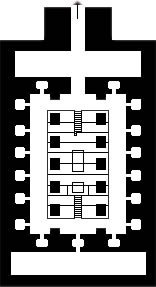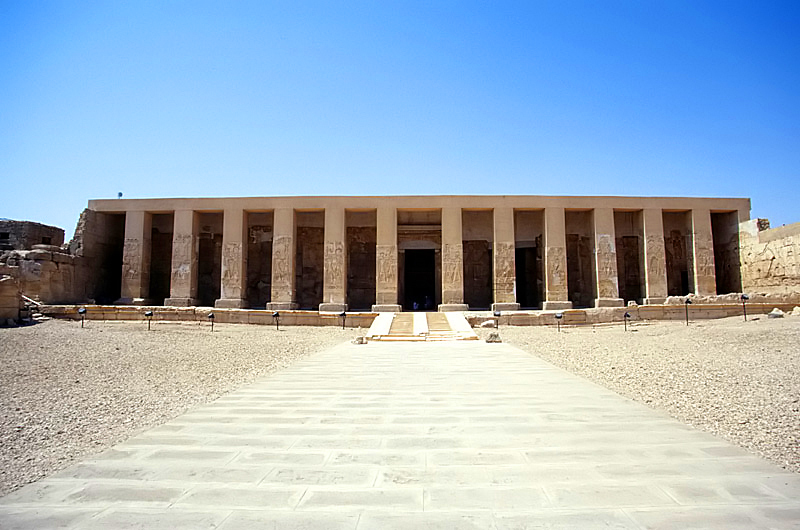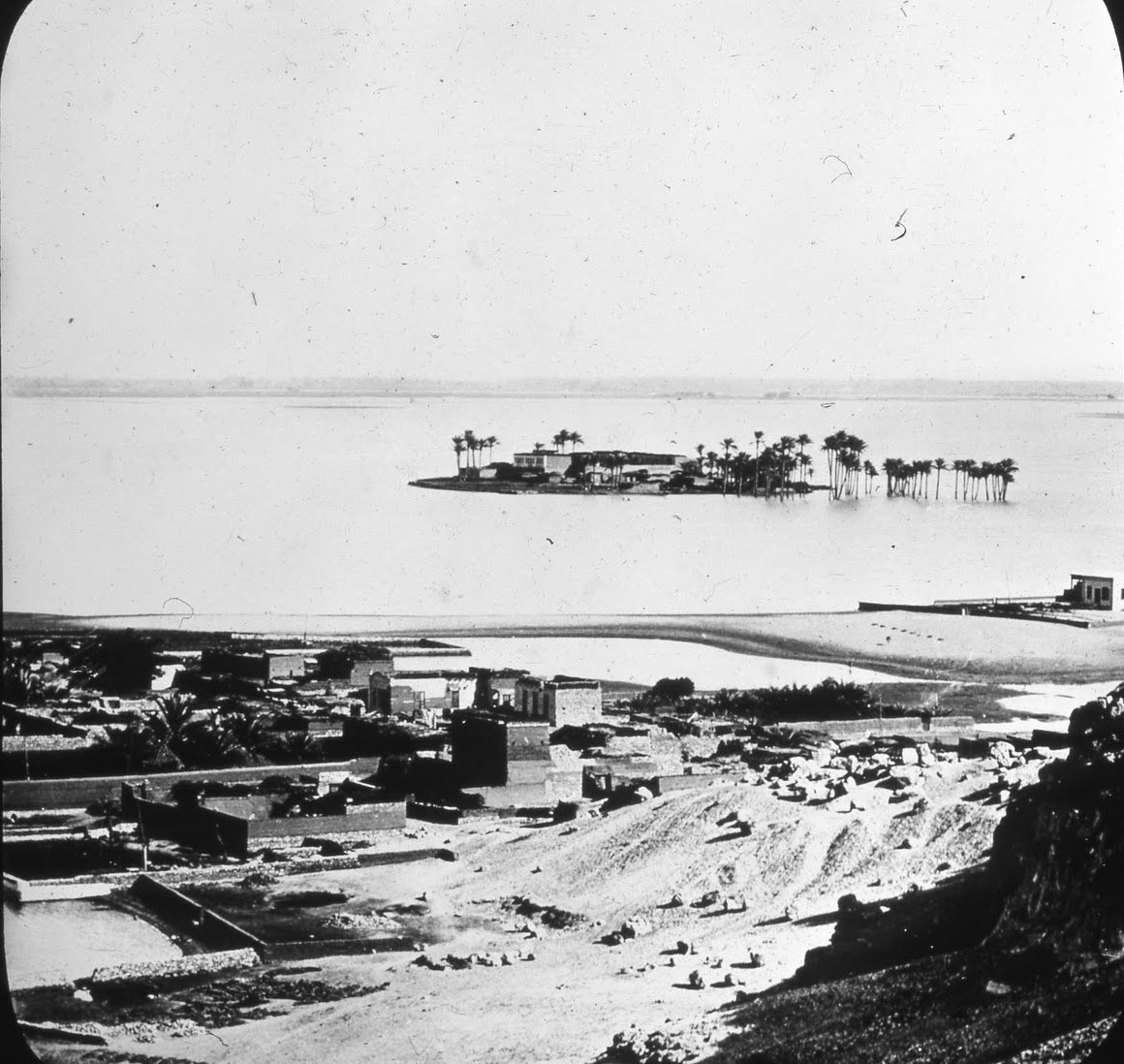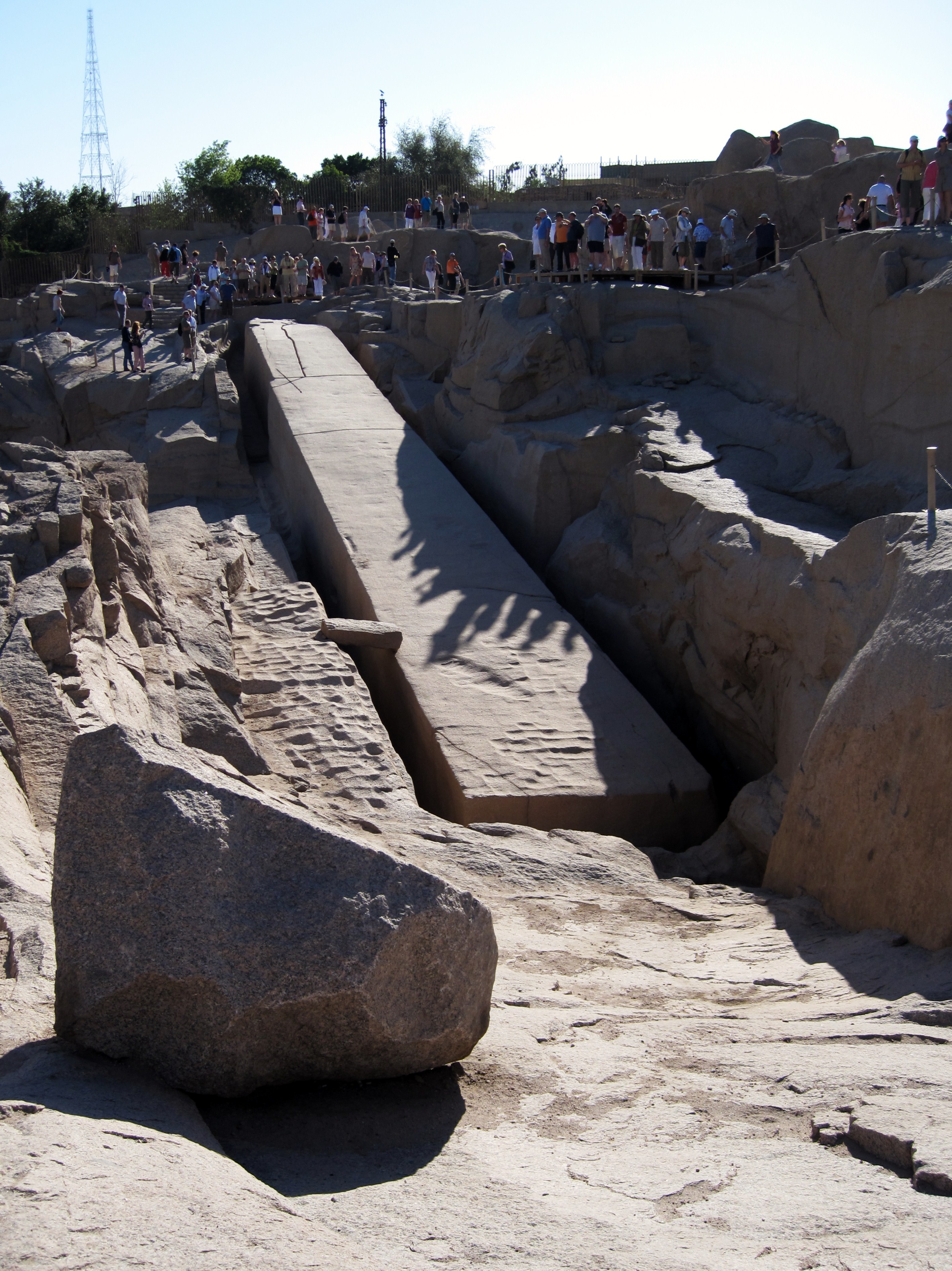|
Osireion
The Osireion (or Osirion) is believed to be the cenotaph of located to the rear of the Temple of Seti I at Abydos, Egypt. The temple was built in the 13th century BC and many researchers believe the Osireion dates from the same period. Seti I ruled from to . Layout and construction The Osireion is part of the Temple of Seti I's complex. It may have been built to resemble the tombs in the Valley of the Kings. It is located centrally behind the main part of the Temple of Seti I along an east west axis. Most of its structure would have been subterranean. It was built at a considerably lower level than the foundations of the Temple of Seti I. However, most of the roof has been lost. There is an entrance tunnel that runs along a north south axis behind the Osireion's central hall. It is long and stone lined. The central hall is constructed with very large stone blocks; limestone interior with sandstone facing. The roof would have been formed of large granite beams. The hall co ... [...More Info...] [...Related Items...] OR: [Wikipedia] [Google] [Baidu] |
Temple Of Seti I (Abydos)
The Temple of Seti I is now known as the Great Temple of Abydos. In antiquity, the temple was known as "Seti I, Menmaatre Happy in Abydos," and is a significant historical site in Abydos, Egypt, Abydos.O’Connor, David. “The Temple of Seti I.” In ''Egypt’s First Pharaohs and the Cult of Osiris'', 95. New York: Thames & Hudson, 2009. Abydos is a significant location with its connection to kingship due to being the burial site of the proto-kings from the Prehistoric Egypt, Pre-Dynastic period, First Dynasty of Egypt, First Dynasty kings, and the location of the Cult of Osiris. Initially, construction started in the 13th century BC by the Nineteenth Dynasty of Egypt, 19th Dynasty Pharaoh Seti I, also known as Seti I, Sethos, but was not completed by the time of his death instead, construction was renovated by his son Ramesses II. The temple was built in order to commemorate and worship the earlier pharaohs of Egypt as well as the major gods of the Egyptian pantheon.Calverley, ... [...More Info...] [...Related Items...] OR: [Wikipedia] [Google] [Baidu] |
Margaret Murray
Margaret Alice Murray (13 July 1863 – 13 November 1963) was an Anglo-Indian Egyptologist, archaeologist, anthropologist, historian, and folklorist. The first woman to be appointed as a lecturer in archaeology in the United Kingdom, she worked at University College London (UCL) from 1898 to 1935. She was president of the Folklore Society from 1953 to 1955, and published widely. Born to a wealthy middle-class English family in Calcutta, British India, Murray divided her youth between India, Britain, and Germany, training as both a nurse and a social worker. Moving to London, in 1894 she began studying Egyptology at UCL, developing a friendship with department head Flinders Petrie, who encouraged her early academic publications and appointed her junior lecturer in 1898. In 1902–1903, she took part in Petrie's Excavation (archaeology), excavations at Abydos, Egypt, there discovering the Osireion temple, and the following season investigated the Saqqara cemetery, both of ... [...More Info...] [...Related Items...] OR: [Wikipedia] [Google] [Baidu] |
Abydos, Egypt
Abydos ( or ; Sahidic ') is one of the oldest cities of ancient Egypt, and also of the Ta-wer, eighth Nome (Egypt), nome in Upper Egypt. It is located about west of the Nile at latitude 26° 10' N, near the modern Egyptian towns of El Araba El Madfuna and El Balyana. In the ancient Egyptian language, the city was called Abedju (''ꜣbḏw'' or ''AbDw'')(Arabic Abdu عبد-و). The English name ''Abydos'' comes from the Greek language, Greek , a name borrowed by Greek geographers from the unrelated city of Abydos, Hellespont, Abydos on the Hellespont. Considered one of the most important archaeological sites in Egypt, the sacred city of Abydos was the site of many ancient Egyptian temple, temples, including Umm el-Qa'ab, a royal necropolis where early pharaohs were entombed. These tombs began to be seen as extremely significant burials and in later times it became desirable to be buried in the area, leading to the growth of the town's importance as a cult site. Today, Abydos ... [...More Info...] [...Related Items...] OR: [Wikipedia] [Google] [Baidu] |
Seti I
Menmaatre Seti I (or Sethos I in Greek language, Greek) was the second pharaoh of the Nineteenth Dynasty of Egypt during the New Kingdom of Egypt, New Kingdom period, ruling or 1290 BC to 1279 BC. He was the son of Ramesses I and Sitre, and the father of Ramesses II. The name 'Seti' means "of Set", which indicates that he was consecrated to the god Set (mythology), Set (also termed "Sutekh" or "Seth"). As with most pharaohs, Seti had several names. Upon his ascension, he took the Prenomen (Ancient Egypt), prenomen "mn-m3't-r' ", usually vocalized in Egyptian as ''Menmaatre'' (Established is the Justice of Re). His better known Nomen (Ancient Egypt), nomen, or birth name, is transliterated as "''sty mry-n-ptḥ"'' or ''Sety Merenptah'', meaning "Man of Set, beloved of Ptah". Manetho incorrectly considered him to be the founder of the 19th Dynasty, and gave him a reign length of 55 years, though no evidence has ever been found for so long a reign. Reign Background After th ... [...More Info...] [...Related Items...] OR: [Wikipedia] [Google] [Baidu] |
Flinders Petrie
Sir William Matthew Flinders Petrie ( – ), commonly known as simply Sir Flinders Petrie, was an English people, English Egyptology, Egyptologist and a pioneer of systematic methodology in archaeology and the preservation of artefacts. He held the first chair of Egyptology in the United Kingdom, and excavated many of the most important archaeological sites in Egypt in conjunction with his Irish-born wife, Hilda Petrie, Hilda Urlin. Some consider his most famous discovery to be that of the Merneptah Stele, an opinion with which Petrie himself concurred. Undoubtedly at least as important is his 1905 discovery and correct identification of the character of the Proto-Sinaitic script, the ancestor of almost all alphabetic scripts. Petrie developed the system of dating layers based on pottery and Ceramic engineering, ceramic findings. Petrie has been denounced for his pro-eugenics views; he was a dedicated believer in the superiority of the Germanic-speaking world, Northern p ... [...More Info...] [...Related Items...] OR: [Wikipedia] [Google] [Baidu] |
Thames & Hudson
Thames & Hudson (sometimes T&H for brevity) is a publisher of illustrated books in all visually creative categories: art, architecture, design, photography, fashion, film, and the performing arts. It also publishes books on archaeology, history, and popular culture. Headquartered in London, it has a sister company in New York City, and subsidiaries in Melbourne, Singapore, and Hong Kong. In Paris it has a sister company, Éditions Thames & Hudson, and a subsidiary called Interart which distributes English-language books. The Thames & Hudson group currently employs approximately 150 staff in London and approximately 65 more around the world. The publishing company was founded in 1949 by Walter and Eva Neurath, who aimed to make the world of art and the research of top scholars available to a wider public. The company's name reflects its international presence, particularly in London and New York. It remains an independent, family-owned company, and is one of the largest publishe ... [...More Info...] [...Related Items...] OR: [Wikipedia] [Google] [Baidu] |
The Journal Of Egyptian Archaeology
The ''Journal of Egyptian Archaeology (JEA)'' is a bi-annual peer-reviewed international academic journal published by the Egypt Exploration Society. Covering Egyptological research, the JEA publishes scholarly articles, fieldwork reports, and reviews of books on Egyptology. Articles are mainly published in English, with contributions in German or French accepted where suitable. The JEA was established in 1914 by the Egypt Exploration Fund. Its editors have included several prominent Egyptologists, including Alan Gardiner (1916–21, 1934, 1941–46); T. Eric Peet (1923–1934) and Battiscombe Gunn (1935–1939). The current (2021) editor-in-chief is of University College London. (Access date 9 May 2021) References External links * Searchable index of article titles 1914~2022(use JEA as abbr. for journal) via University of Toronto The University of Toronto (UToronto or U of T) is a public university, public research university whose main campus is located on t ... [...More Info...] [...Related Items...] OR: [Wikipedia] [Google] [Baidu] |
Tufts University
Tufts University is a private research university in Medford and Somerville, Massachusetts, United States, with additional facilities in Boston and Grafton, as well as Talloires, France. Tufts also has several Doctor of Physical Therapy programs located in Boston, Phoenix and Seattle. It was founded in 1852 as Tufts College by Christian universalists who sought to provide a nonsectarian institution of higher learning. Tufts remained a small liberal arts college until the 1970s, when it transformed into a large research university offering doctorates in several disciplines. The corporate name of the university is "Trustees of Tufts College". Tufts offers over 90 undergraduate and 160 graduate programs across ten schools in the greater Boston area and Talloires, France.Bylaws ... [...More Info...] [...Related Items...] OR: [Wikipedia] [Google] [Baidu] |
Internet Archive
The Internet Archive is an American 501(c)(3) organization, non-profit organization founded in 1996 by Brewster Kahle that runs a digital library website, archive.org. It provides free access to collections of digitized media including websites, Application software, software applications, music, audiovisual, and print materials. The Archive also advocates a Information wants to be free, free and open Internet. Its mission is committing to provide "universal access to all knowledge". The Internet Archive allows the public to upload and download digital material to its data cluster, but the bulk of its data is collected automatically by its web crawlers, which work to preserve as much of the public web as possible. Its web archiving, web archive, the Wayback Machine, contains hundreds of billions of web captures. The Archive also oversees numerous Internet Archive#Book collections, book digitization projects, collectively one of the world's largest book digitization efforts. ... [...More Info...] [...Related Items...] OR: [Wikipedia] [Google] [Baidu] |
List Of Megalithic Sites
This is a list of monoliths organized according to the size of the largest block of stone on the site. A monolith is a large stone which has been used to build a structure or monument, either alone or together with other stones. In this list at least one colossal stone over ten tons has been moved to create the structure or monument. In most cases ancient civilizations had little, if any, advanced technology that would help them move these monoliths. The most notable exception is that of the Ancient Egyptians, Ancient Greece, ancient Greeks and Ancient Rome, Romans, who had Roman crane, cranes and Treadwheel crane, treadwheels to help lift colossal stones (see List of ancient monoliths, list of ancient Greek and Roman monoliths). This article also includes a list of modern experimental archaeology efforts to move colossal stones using technologies available to the respective ancient civilizations. Most of these weights are based on estimates by published scholars; however, there ... [...More Info...] [...Related Items...] OR: [Wikipedia] [Google] [Baidu] |
Egypt Exploration Society
The Egypt Exploration Society (EES) is a British non-profit organization founded in 1882 for the purpose of financing and facilitating the exploration of significant archeological sites in Egypt and Sudan, founded by writer Amelia Edwards and coin curator Reginald Stuart Pool. It is based in London and is a registered charity. The organization has worked at many major Egyptian excavation sites, including Deir el-Bahri, Tanis, Abydos, and Amarna. According to the Society, findings from over 150 of their projects and excavations have been published around the world. History In 1873, the English writer Amelia Edwards ventured to Egypt to escape Britain's cold, rainy climate and sight-see. She and several friends traveled up the Nile River, from Cairo to Abu Simbel. On her return in 1876, Edwards published her account of the trip as ''A Thousand Miles Up the Nile''. The book became renowned for its description of 19th-century Egypt and the largely un-excavated antiques she encounter ... [...More Info...] [...Related Items...] OR: [Wikipedia] [Google] [Baidu] |
Twelfth Dynasty Of Egypt
The Twelfth Dynasty of ancient Egypt (Dynasty XII) is a series of rulers reigning from 1991–1802 BC (190 years), at what is often considered to be the apex of the Middle Kingdom of Egypt, Middle Kingdom (Dynasties XI–XIV). The dynasty periodically expanded its territory from the Nile delta and valley South beyond the Cataracts of the Nile, second cataract and East into Canaan. The Twelfth Dynasty was marked by relative stability and development. It has a notably well recorded history for the period. Its first pharaoh was Amenemhat I and its final was Sobekneferu. History The chronology of the Twelfth Dynasty is the most stable of any period before the New Kingdom of Egypt, New Kingdom. The Turin King List, Turin Royal Canon gives 213 years (1991–1778 BC). Manetho stated that it was based in Thebes, Egypt, Thebes, but from contemporary records it is clear that the first king of this dynasty, Amenemhat I, moved its capital to a new city named "Amenemhat-itj-tawy" ("Amenemha ... [...More Info...] [...Related Items...] OR: [Wikipedia] [Google] [Baidu] |






